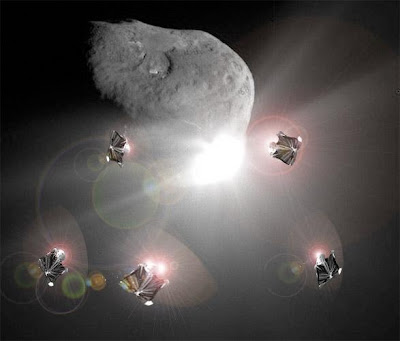Tuesday, 12 April 2011
Friday, 1 April 2011
Space Freight Cars
 We have already found asteroid belts around other stars. In fact, the star Epsilon Eridani has three nested belts. NASA's Spitzer Space Telescope has been prolific at picking out the thermal signature of extraterrestrial asteroid belts.
We have already found asteroid belts around other stars. In fact, the star Epsilon Eridani has three nested belts. NASA's Spitzer Space Telescope has been prolific at picking out the thermal signature of extraterrestrial asteroid belts.Any growing space faring civilization would recognize asteroids as an abundant source of raw materials. They are the coal cars in a freight train of planets.
But finding asteroid belt anomalies that would convincingly point to the handiwork of space aliens would be very tricky. First, we would need to presume that the civilization was so advanced that it built -- at huge expense -- the transportation infrastructure for getting back and forth to the asteroid belt. Advanced robots would have done all the heavy lifting for mining and transporting asteroid material to space-based factories.
Forensic clues could come from identifying a chemical disequilibrium in the belt caused by the extraction of specific minerals and elements. Second, the system might look odd due to the dis assembly of its larger asteroids. Finally, large quantities of dust from mining might give the belt an unusual temperature distribution.
The researchers predict that persistent mining over long periods will artificially reduce the number of larger asteroids in the system debris. All that would be left would be pebble-sized and smaller dusty debris. No space telescope envisioned could inventory the true asteroid sizes, but differences in the dust distribution might offer clues.
Five Historic Hoaxes
 Hoaxes have long been a part of history, from the ancient Greeks to modern day. In celebration of April Fool's Day, count down with us some of the greatest moments of trickery known to man.
Hoaxes have long been a part of history, from the ancient Greeks to modern day. In celebration of April Fool's Day, count down with us some of the greatest moments of trickery known to man.n Halloween night, 1938, a radio broadcast of H.G. Wells' 1898 science fiction novel "The War of the Worlds" had people convinced that aliens were invading the United States. The broadcast was orchestrated by the famous Orson Welles (pictured above, answering questions from the press the following day).
Much of the show was in an "emergency bulletin" format. Those who tuned in mid-broadcast didn't recognize that they had stumbled upon a fictional show and instead thought they had tuned in just in time to hear emergency announcements that aliens were invading. Welles claimed he hadn't foreseen the hysteria.
Subscribe to:
Posts (Atom)